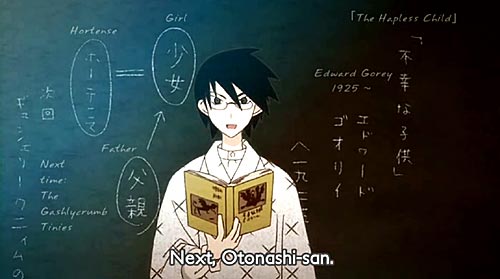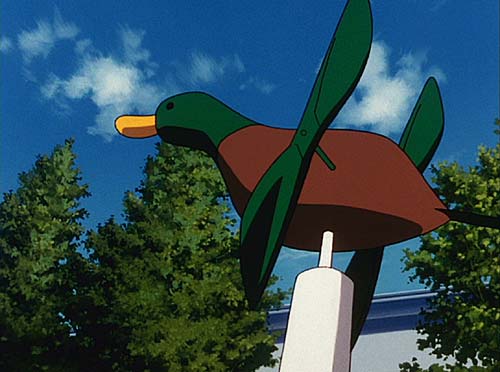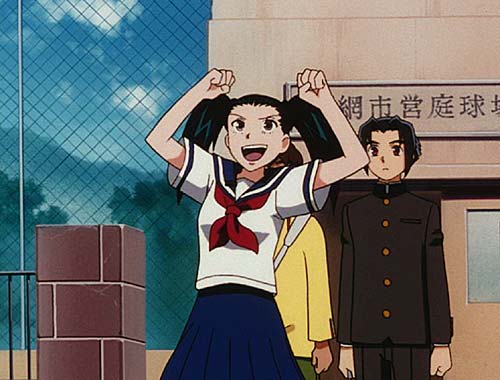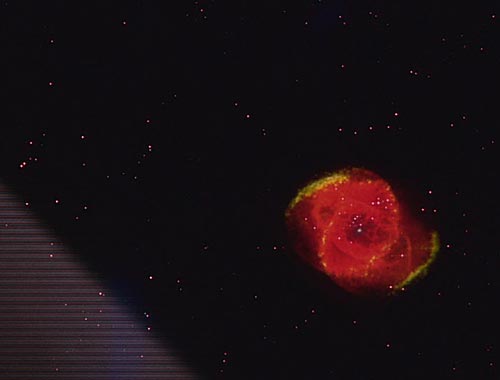Yep.
Tag: Current viewing
Form, truth and regret
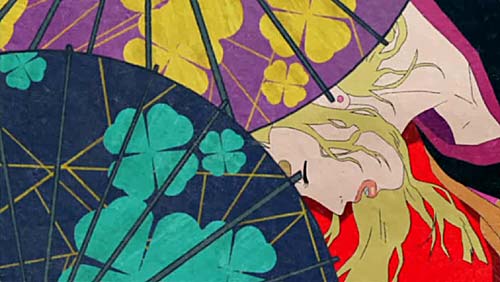
I will withhold comments on the merits of Mononoke until I’ve watched a few more episodes and have seen whether the payoff of the horror story is worth the buildup. Instead, here are some screen captures illustrating the novelties of this moving wood-block print. Note the off-center and unbalanced compositions, eccentric angles and busy detail contrasting with empty space.
Update: Wabi Sabi has a weblog devoted to Mononoke. (Beware of spoilers.)
Exceedingly random notes
I’ve watched very little anime recently, mainly because I’ve been playing with my new toy. It’s as much computer as camera, and learning everything it’s capable of is a major project. (Not that it’s hard to use — put it on “auto” and it is a superior point-and-shoot.) I’ve been posting some of the pictures on my other weblog, starting with “90/365.”
*****
The third episode of Sayonara Zetsubou Sensei doesn’t begin with an attempted suicide, which is a bad omen for this black-humored satire. This week’s flakes are a blonde with a dual personality and an illegal immigrant. Unfortunately, Itoshiki disappears in the last third of the show, and Kafuka doesn’t have the same chemistry with obsessive-compulsive Chiri as she does with Mr. Despair. While tasteless humor is to be expected in this sort of show, some of the gags cross the line, notably a brief allusion to pedophilia. Although SZS remains the least unfunny of the current comedies that I’ve seen (Oh! Edo Rocket is something more), I’m still underwhelmed. I watched it a second time, pausing to read all the graffiti on the blackboard, and it wasn’t worth the effort.
Otherwise, I’ve been rewatching Shingu. I’m half-way through and, once again, I’m in no hurry to finish it. I may make some time this week to get caught up with Denno Coil; four new episodes were posted in the last three days, after a three-week dry spell. I may also take a look at Mononoke.
*****
A couple of weblogs that might be worth keeping track of:
FictionJunction J-music — Julien writes about and posts samples of anime soundtracks and other Japanese music.
Japanese words of anime fans … — Discussion of Japanese terms of interest to anime viewers. Many of the words I would prefer not to learn, but it is a potentially useful site nevertheless. (Via Wabi Sabi and Nick.)
*****
Sailor Moon remains a constant menace. Usagi Tsukino and her cohorts currently pose two fresh threats. First, there is a “Sailor Moon” game in development for the Wii. Fortunately for the West, it will probably be region-restricted to Japan. And if that isn’t frightening enough, Usagi herself is poised to strike Japan as a major typhoon:
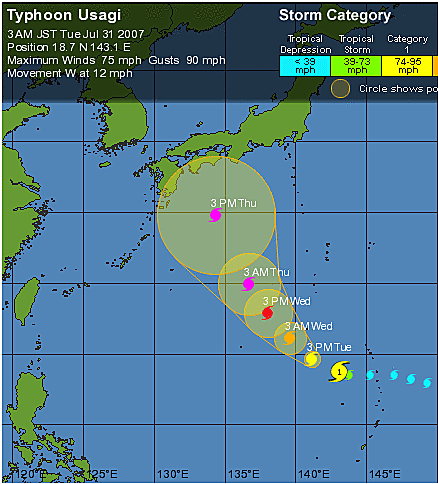
I hope Ken is packing an umbrella.
Pink Supervisor
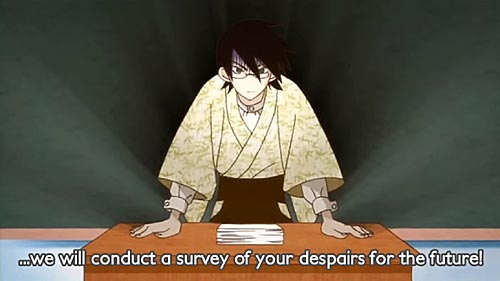
In Sayonara Zetsubou Sensei, or So Long, Mr. Despair, the pessimistic teacher Nozomu Itoshiki, who begins each episode with a suicide attempt, discovers the implacably optimistic girl Fuura Kafuka (does that name sound familiar?) in his class. Her classmates through the second episode include a hikikomori, an obsessive-compulsive perfectionist, a girl who communicates only through text messaging, and a stalker; undoubtedly there will be many other healthy-minded young people to meet in the remaining ten episodes of this grim farce.
The opening is the cheapest I’ve seen, just text with do-it-yourself music. Overall, I would describe the production as economical, if occasionally elegant in its low-budget way. It suits the one-dimensional characters and absurd stories well. The show is noteworthy for its graffiti: the chalkboard features comments and wisecracks from Koji Kumeta, the artist responsible for the manga on which the anime is based. There are also jokes for otaku, though the show doesn’t depend on them the way Lucky Star and Hayate do.
Sayonara Zetsubou Sensei is obviously not for everyone. I’ve uploaded the first eight seconds of the first episode to my video weblog. If you find it amusing, you might want to check out the series.
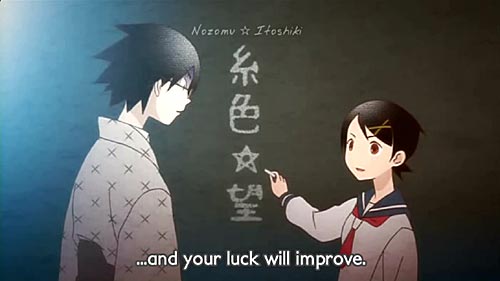
Update: Astro is also watching Sayonara Zetsubou Sensei, and he has many more screen captures. (I would guess that the guy whose face turns up in all the odd places is Kumeta.)
Update II: It occurs to me that SZS is anime as Edward Gorey would have done it.
*****
This is likely my last substantive post for a while. I picked up Harry Potter #7 yesterday (I want to see for myself what happens before anyone spoils it for me), which will probably take care of the rest of today. Tomorrow my New Toy is scheduled to arrive, and that will occupy all my free time for a week or two or three. I’ll be back eventually, and perhaps by then there will be fresh episodes of Denno Coil, Oh! Edo Rocket and maybe even Master of Epic waiting for me.
Cold fuzzies
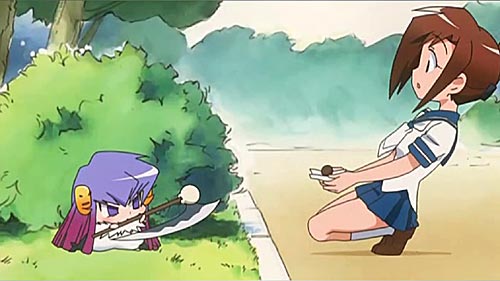
Reaction to Potemayo: not enough Guchuko (above, left), too much Mikan (below). I could have done without the Brokeback Mountain reference, too. And the boys in skirts. And the incontinent chibi. Never mind.
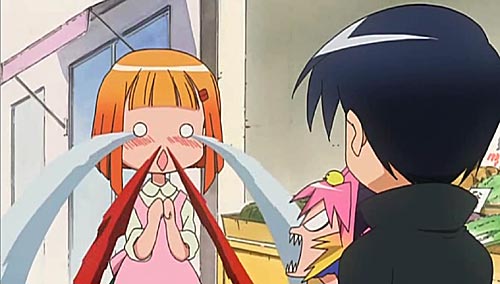
By the way, Guchuko indeed wields an axe, not a scythe. This is a scythe:
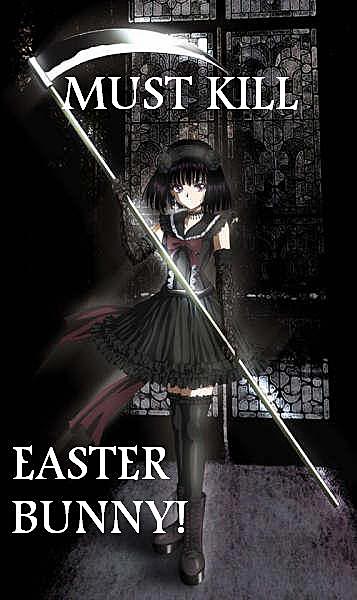
(Goth Hotaru via Ken.)
Post script: I probably am being a little unfair to Potemayo. The central character, Sunao, is quiet and level-headed, something I appreciate in anime as well as in real life. Although there is a definite whiff of shounen-ai, one of the boys involved is a gonk; i.e., the point is not titillation.
Nevertheless, I wonder just who the target audience is. Potemayo and Guchuko — I expect that the plushies are already heading to market — will likely fascinate pre-literate fans of Binchou-tan, but the satirical aspects of the show will go over their heads. Those who can spot the subverted tropes will likely suffer from a kawaii overdose from the title character/thing. I’m mildly curious to see if any explanation is eventually offered for the chibis’ presence in this universe, but there is a limit to how much cute (or Mikan) my system will tolerate.
J-pop and worse
I’ve posted the opening of Oh! Edo Rocket on the video weblog. I also a uploaded a clip of the “abacus dance.”
It was trivially easy to add the 1 Bit Audio Player to my music pages, so you don’t have to actually download the mp3s to sample the tunes, or whatever you want to call them.
Rocketeering
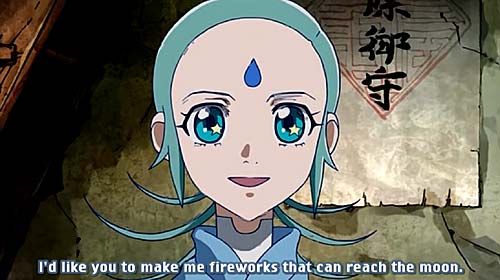
In the summer of 1842, anything that’s fun is illegal in Edo. This includes all forms of entertainment, technological innovations and, in particular, fireworks. The policeman Akai assiduously enforces the law with a particular emphasis on the Furai terrace house, whose inhabitants include the fireworks artisan Seikichi and his mathematician brother Shunpei. One day, after an unpleasant encounter with Akai, Seikichi returns to his room to find a strange, pretty young woman with stars in her eyes (literally) and blue hair who tells him to call her “Sora.” She has a modest request for him: can he make a rocket that will go to the moon?
Oh! Edo Rocket is a collection of disparate elements, starting with the character art. There are at least three distinct styles represented. Seikichi, Shunpei and Sora have classic anime big eyes and small (but definite) noses. (Their mouths are larger than is standard nowadays, though. Seikichi’s is downright big.) Akai, the locksmith Ginjiro and other older characters have normal-sized eyes and relatively realistic faces, and they are considerably taller than Seikichi. Finally, there’s a collection of cartoony grotesques who could have stepped out of a Jay Ward production. These all are as short as Boris Badenov, barely reaching Ginjiro’s knee, with oversized heads. (I posted a portrait gallery earlier.)
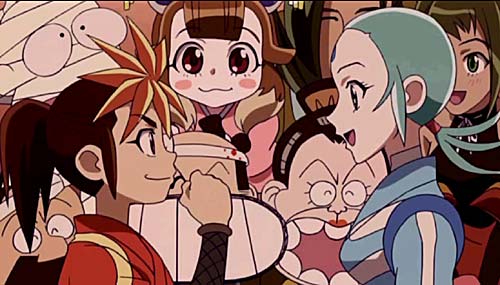
In addition to these, there are strange creatures lurking about. One of these is a pale “sky beast,” apparently intelligent, and capable of zapping its enemies with electrical discharges. The magistrate Torii and his secret police pursue the creature, but as of episode two they have yet to capture it.
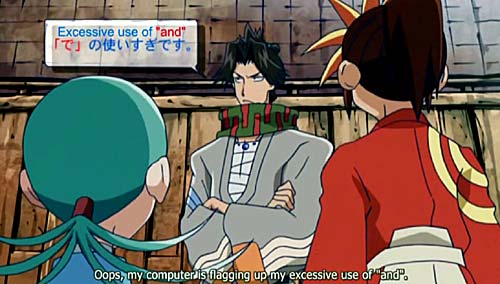
Other elements include a jazz soundtrack, frequent anachronisms and breaks in the fourth wall. There’s a self-pitying effeminate bishounen whom nobody notices. There aren’t any meganekko or nekomimi so far, but there is Onui, the “watchdog for public morality,” who is distinctly puppyish. There are giant rabbits on the moon.
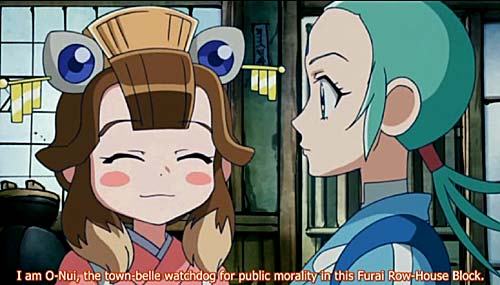
Oh! Edo Rocket is mostly farce, but there’s menace under the comedy. The inventor Shinsa is hauled off to jail at the end of the first episode. He returns in the second, covered from head to toe with bandages because he refused to inform on Seikichi. The heavily armored secret police are absurd — one travels by turning cartwheels so quickly that he is a blur — but they are also scary. The regular police seem as competent as the Keystone Cops, but Akai is observant enough to be dangerous.
Whether the show’s creators can pull all these heterogenous elements into a unified whole remains to be seen. A stage play, a novel and an earlier television series preceeded the anime, so presumably the writers have some idea of where they’re going with the story. There’s nothing else much like it, so I’ll probably continue to follow it.
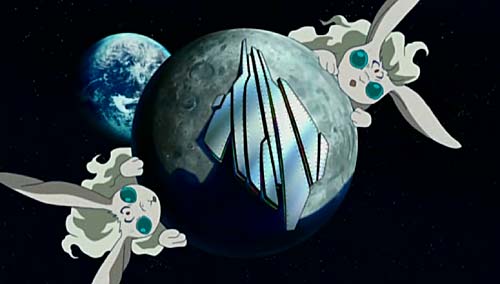
Other matters, and the lady or the tiger?
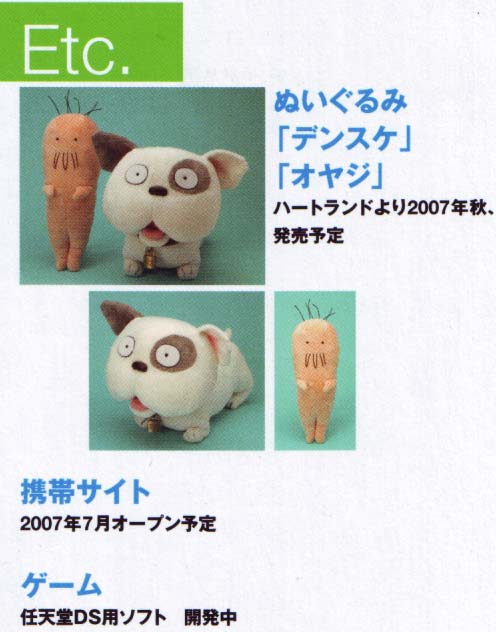
Inevitably, plushies of Denno Coil creatures will soon be available in Japan. Owners of the Densuke doll will be one-up on Yasako, who doesn’t know what her cyberpet feels like. (But where are the mojos?)
*****
After some experimentation with ffmpegX, I managed to encode a watchable flash file of the opening to Animal Yokocho, which I’ve posted on the video weblog. Apparently, the quality of the playback is more a function of the computer it’s viewed on than of the size of the file. On my aging Mac at home with its antique video card, playback is annoyingly jumpy, but here at the office (it’s lunchtime) on my newer, faster machine, it’s acceptable. Though it’s hardly a classic, the AniYoko opening does its job quite well, with cheerful, energetic music and imagery that advertises that anything can happen. Animal Yokocho deserves more attention that it gets; it’s a kid’s show that adults can enjoy as much as their children. It’s a pity that it will probably never be licensed. (For more on the joys of working with Flash, see Astro’s account of his experiments.)
*****
The thirteenth episode of Seirei no Moribito was the first that disappointed me. It’s a good story, and the fight scenes were every bit as spectacular as those in the third episode, but the script was clumsy. The symbolism, not exactly subtle to begin with, was highlighted, then underlined, then explicitly explained as if the viewer were in a ninth-grade English class. The rampaging Balsa deserved better. Perhaps not coincidentally, this was the first episode with an unequivocally evil character.
The other Haruhi and other nonsense
A bunch of stuff was recently licensed. The most interesting news is the title that wasn’t there. Ouran High School Host Club, in my opinion the outstanding show of the non-banner year 2006, has still not been licensed. I presume that it’s a matter of money; otherwise, it is incomprehensible that dreck like OtoBoku gets a region 1 release and Ouran doesn’t.
Random notes on some of the other shows:
The original Genshiken was okay, but just okay, and the three episodes of Kujibiki Unbalance were all that was necessary. The additional episodes will likely demonstrate that “more is less.”
Darker Than Black is a possible buy, but I want to read some reactions to the complete series before I invest time and money in it. Is there substance under the glossy finish?
I watched half of the first episode of Victorian Romance Emma and, well, I was bored. I daresay I would find it fascinating if I could get into the rhythm. It can wait.
Gurren-Lagann is another possible buy. Again, I’ll wait for reports on the entire series before making a decision.
The first three episodes of Nanoha seemed to me to be an inferior version of Cardcaptor Sakura. Things start getting interesting in the fourth episode with the appearance of another mahou shoujo, but by that point I was thoroughly repulsed by the transformation sequence, which was storyboarded with dirty old men in mind. I never thought I’d say this, but I am not interested in watching any more of Nanoha unless it’s censored.
*****
Today’s Words of Wisdom: Too much Freud is bad for you.
*****
The first episode of Sola has two things going for it: a photographer, albeit a flaky one; and, the three inches between the hem of the girl’s very short skirt and the top of her stockings. ((This motif turns up a lot in anime, e.g., Yomi in Azumanga Daioh, but I don’t think I’ve ever seen a real-life example.)) Astro gave the series a “B,” so I may watch the rest sometime, but it’s not high priority.
*****
None of the summer’s series look particularly promising. I may watch the first episode or two of Tetsuko no Tabi, which seems to be the least stereotypical offering. If the characters are interesting, it could be fun.
*****
I see that Gedo Senki has been fansubbed. I will not be downloading it. I like the books too much.
Go with the flow
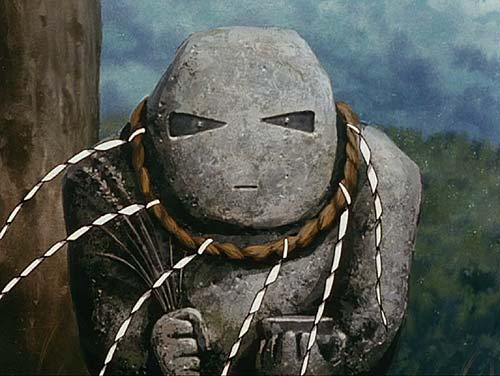
I finished Shingu. The final episodes were spectacular and largely satisfying, but I want to think about them a bit before I declare the show a complete success. I will say that it is a superior series that I can recommend to anyone who likes imaginative, surprising stories.
Show time
As I expected, the story has gotten darker as it nears the climax, but Shingu is still a great deal of fun.
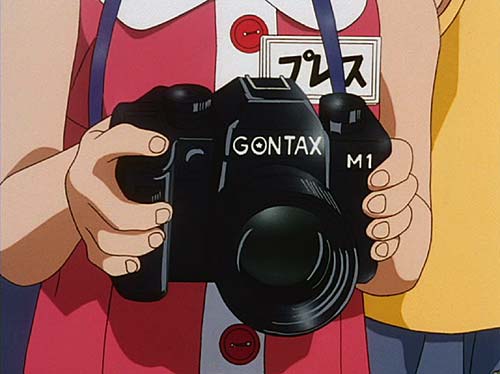
German cameras. ((There are two different brands alluded to here, Contax, obviously, but also the M-series Leica (though the latter were rangefinder cameras, not SLRs like Futaba’s camera).)) So they still shoot film in 2070?
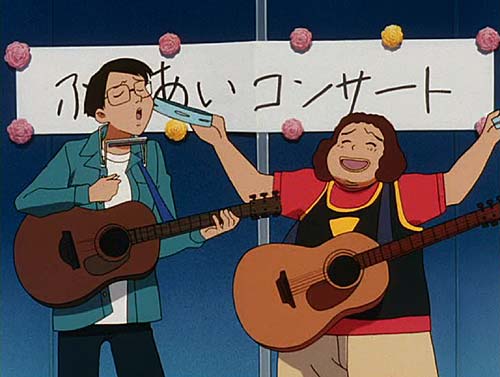
Embarrassing music
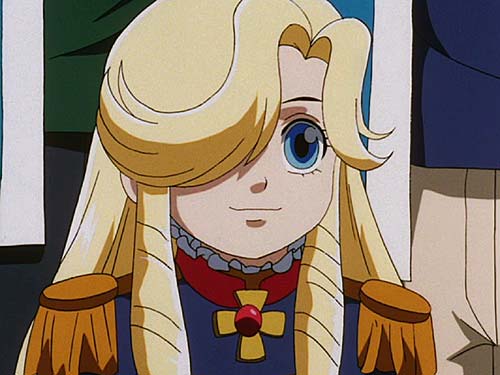
Boy or girl?
Bonus link: Ubu on what didn’t happen.
Incidental pleasures II
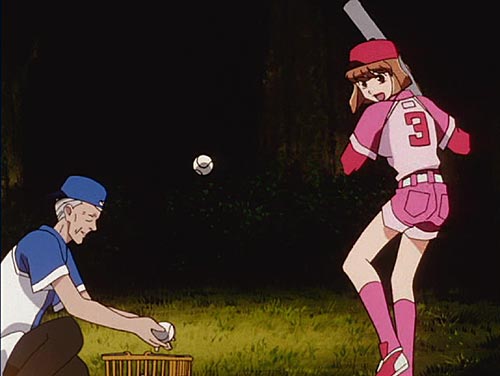
Baseball as a martial art
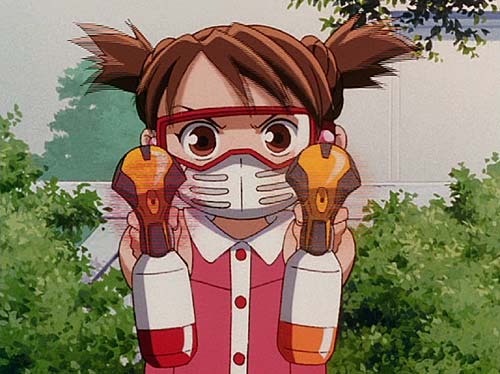
Armed and dangerous little sisters
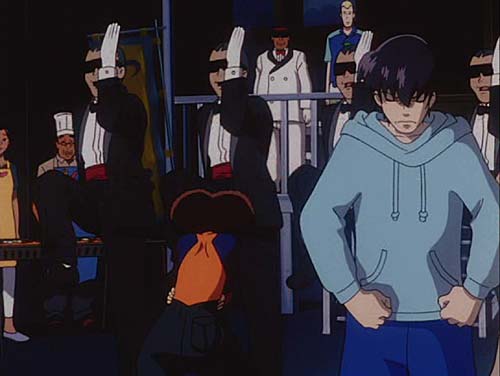
Dancing aliens in tuxes
*****
Sometimes I have got to know What Happens Next. This was the case with Patricia McKillip’s Riddlemaster trilogy, which I read in one (long) sitting, and with Misaki Chronicles, which I watched in one evening. Other times, I want to go slowly and savor every little bit. I spent a week on John Crowley’s Little, Big, and not because it was a thick book. I’ve got two discs left of Shingu left, and I’m not going to rush through them. I’m enjoying the series too much. There are still surprises in every episode, even though I’m past the half-way point and the characters are old friends now.
Earlier this year I wondered if I’ve seen all the first-rate anime that’s available. This month I watched Divergence Eve/Misaki Chronicles and I’m in the middle of Shingu. Denno Coil also has been excellent so far. My interest in anime will eventually diminish, but it won’t happen as soon as I expected.
While there is still first-rate anime to be found, anime criticism remains a scandalously inept guide. Reviews of the Misaki saga range from limp to stupid, and there are virtually no reviews of Shingu at all. If Steven hadn’t written about them, I would never have bothered with either.
Incidental pleasures of Shingu
Bulletin from the Galactic Federation
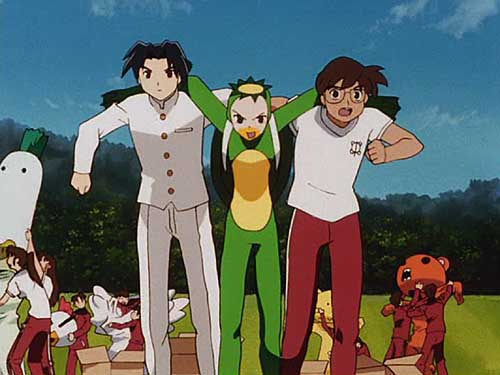
Shingu is the perfect show to recover with after Divergence Eve/Misaki Chronicles. The fate of the Earth, perhaps the entire galaxy, may hang in the balance, but six episodes in, the outstanding characteristic of the show is its playfulness.
Advisory

Misaki Chronicles and Shingu just arrived. Don’t expect much posting here for a few days.
Update: Just finished Misaki Chronicles. A few quick notes:
1. Wow.
2. I want to let the story settle in my mind a day or two before I watch anything else. Shingu will have to wait.
3. Somebody please shoot the character designer and the jiggle choreographer.
4. Misaki and her colleagues are cute — from the neck up, anyway — but Lyar von Ertiana is the one I want to meet.
5. Much of the anime that I find memorable deals with grief and despair. Few series do so as directly as Misaki Chronicles.
6. Wow, again.
A tale of two Yukos and other stories
I’ve watched each of the first five episodes of Denno Coil at least twice so far. I have a few small reservations, but overall I’m very impressed. Iso and company have yet to stumble. If these five episodes are indicative, this is the best show I’ve seen on fansub yet and one of the best of any kind ever. I was initially concerned that there wouldn’t be enough material to stretch twenty-six episodes; now my concern that twenty-six will barely be enough to elucidate all the mysteries of Daikoku City and the connections between Yasako and Isako. Denno Coil is a pleasure to watch on every level. I don’t often write about quality of animation because I don’t have the background, but even I can tell that the work here is exceptional. Watching the different ways the various characters in the opening climb stairs is an education in the art of animation. Daikoku City may be a virtual world, but it’s one of the most believable I’ve ever visited.
Eleven episodes of Seirei no Moribito have been translated now. The last few have been surprisingly quiet (not that I mind; there are few things duller than non-stop action). It looks like the story might be as much about the education of the prince as about eluding assassins.
I’m watching Sugar, a Tiny Snow Fairy slowly, one episode a day. I watched the ninth today, which is the beginning of the “Bear Pianist” arc, my favorite part of the series. Overall, it’s as good as I remember it, but not all parts have aged equally well. The Elder’s infatuation with Ginger gets old fast, and after the fluid animation of Denno Coil, Sugar looks just a little wooden. The writing and acting generally are very good, though, and the music is better than I remembered. One recurring theme reminds me strongly of Metamora, and I keep expecting to hear Malcolm Dalglish’s dulcimer.
Addendum: Here’s some Denno Coil motivation.

